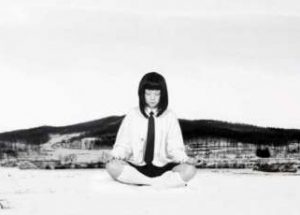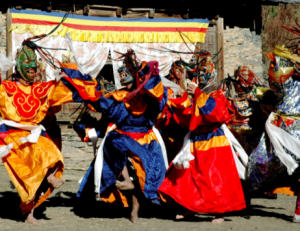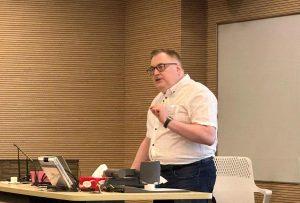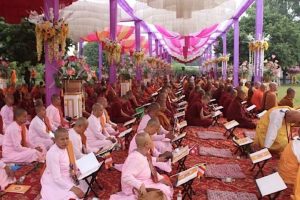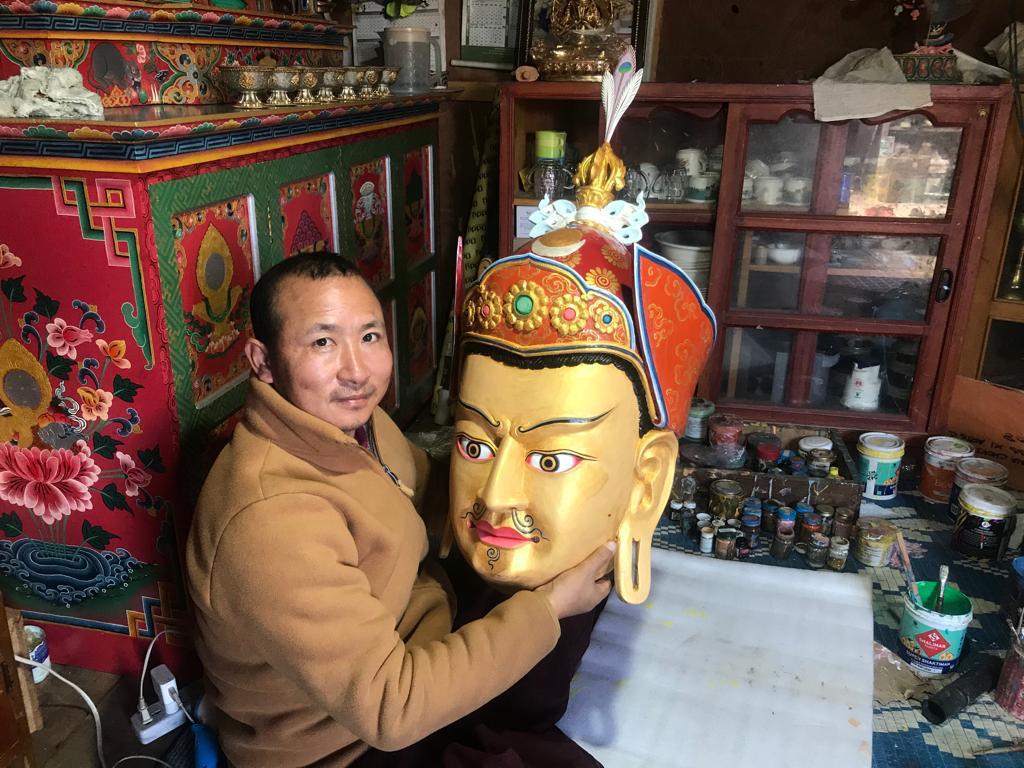
There is now a modern road connecting to the once isolated and remote Himalayan village of Nabji in Bhutan. It was in Nabji, over the cusp of the winter solstice in 2005, that Core of Culture’s dance research and documentation team witnessed the anthropologically rich Nabji Drup, a five-day dance festival comprised of Stone Age dance elements, and elements from Padmasambhava (Guru Rinpoche) in the eighth century, as well as distinct tantric Buddhist choreographies from tantric treasure revealers of the 14th and 15th centuries: Dorje Lingpa (1346–1405) and Pema Lingpa (1450–1521).
The lingpa appellation indicates that the person so-named is a terton or treasure revealer. Among the wisdoms revealed by treasure revealers are whole sets of yogic dances, which appeared to them during visions of Guru Rinpoche’s otherworldly paradise. In Bhutan, such treasure dances have been carried on in unbroken performances for more than 600 years and are rare examples of near pristine ancient dance lineages, such as appear in Nabji.
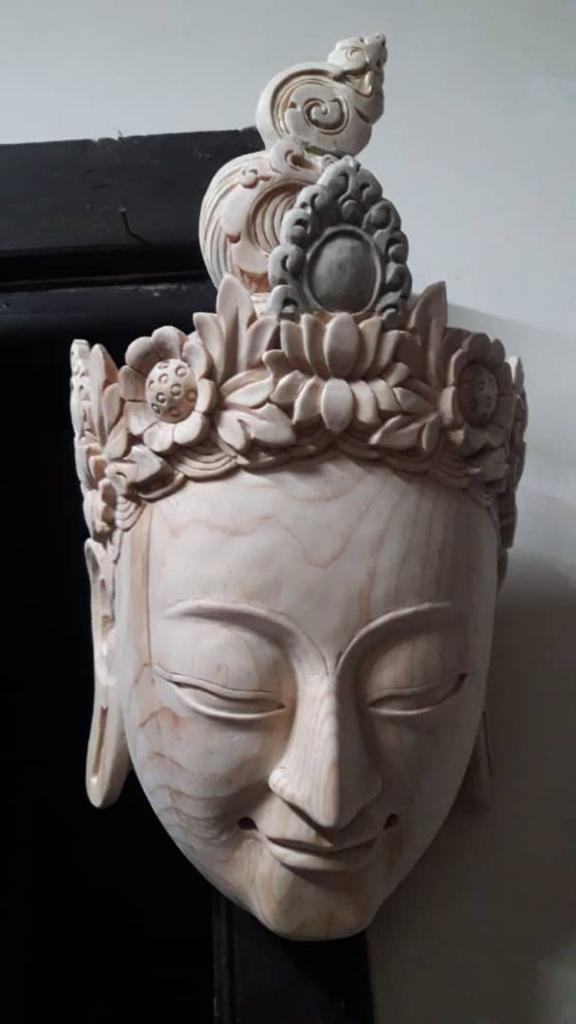
Dorje Lingpa dances are fewer, less well-known, and more endangered than Pema Lingpa dances. Pema Lingpa is a popular Bhutanese saint whose dances are celebrated symbols of Bhutanese culture. Academic scholarship about both of these extraordinary men has tended omit mention of their lasting work in dance and the initiation of distinct dance lineages still extant today. This is also true of academic appreciations and work on Guru Rinpoche—his prolific work as an institutor of dance in tantric Buddhism is often overlooked. In fact, nothing is more central to tantric Buddhism than its dances. It is critical to study the dance aspect, if only for the sake of accuracy in depicting individuals and cultures.
Cham is considered the apotheosis of mystical attainment in tantric Buddhism; living knowledge, embodied wisdom, experienced internally, shared with all. Nabji is at least 700 years older that its neighboring village, Korfu, and the two villages are often referred to as Nabji-Korfu. In fact, people from Nabji were among the earliest inhabitants of Korfu, a place identified by Pema Lingpa as ideal for Dzogchen meditation practice, first as a Dzogchen retreat center, then gradually built up into a village. It is not surprising that Nabji’s Naked Dance is performed in Korfu or that Pema Lingpa dances from Korfu are included in the older Nabji Drup dance festival.
A simple listing of the five-day Nabji Drup program follows here, color-coded to identify dances with pre-Buddhist origins, the dances of Pema Lingpa, and the dances of Dorje Lingpa, who is specifically identified with Nabji and the Naked Dance. The Pema Lingpa elements came from Korfu, about a two-hour trek from Nabji.
This is a general breakdown of three dance influences. Among the dances listed here as part of the Pema Lingpa tradition are elements with older roots in exorcistic practices. These were taken altogether with Pema Lingpa dances from neighboring Korfu. Most ancient rituals contain elements of earlier rites within them.
Nabji Drup Program
Day 1, 24 December 2005
1. Atsara Apa Pre-Buddhist
2. Zha-nak. Dorje Lingpa
3. Ging-zhi Pema Lingpa
4. Trelging Karnak Pema Lingpa
5. Tshok cham Dorje Lingpa
6. Mewang (fire ceremony) Pre-BuddhistDay 2, 25 December 2005
1. Shinjey
2. Zhao li (Yulema)
3. Ju-ging
4. Durdag
5. Dri-ging
6. Nga-ging
7. Dorje Lingpa
8. Drel cham
9. Ter cham (naked dance) also attributed to Dorje LingpaDay 3, 26 December 2005
1. Shazam
2. Dorling Pacham
3. Ging Tsholing
4. Pholey Moley
5. Drel cham
6. Ter cham (naked dance) also attributed to Dorje LingpaDay 4, 27 December 2005
1. Chung tsam
2. Pa cham
3. Raksha Gocham
4. Mang cham
5. Drel cham
6. Ter cham (naked dance) also attributed to Dorje LingpaDay 5, 28 December 2005
1. Dorling Ngacham
2. Durdag
3. Gin sek (fire ritual)
4. Phur cham
In the five days of dancing, there are seven Dorje Lingpa dances among 28 distinct dances. This includes the Naked Dance, which clearly has dance elements from the Dorje Lingpa tradition as well as Stone Age elements.
The Dorje Lingpa tradition lives on at Jambay Lhakhang in Bumthang and few other places. Several other revealed dance traditions in Bhutan, such as that of Woogpa Lingpa, have ceased being performed. Years back, a khenpo, or Buddhist philosophy professor, Khenpo Passang, was asked by the Bhutanese national Buddhist order, the Drukpa Kagyu, to head a dying Dorje Lingpa monastery in a remote area. The Dorje Lingpa traditions are continuing, precariously upheld in honorable adapted ways. Nevertheless, these changes indicate compromises. At Nabji, the historical caretakers of the Dorje Lingpa tradition, the house of the Chakar Lam in Bumthang, have in this generation abandoned their duties toward the Nabji dances.

COVID-19 has also not been kind to ritual ceremonies. The Nabji Drup dance festival has not been performed for two years. These annual performances, repeated over five days, are part of the collective memory and are themselves a mode of transmission. The natural rhythm of this flow of ritual knowledge and wisdom within the community of Nabji has therefore been challenged by these times.
Abbot Khenpo Kinley Gyaltsen is the head of small monastery in Ura, Bumthang. His late father was born in Nabji. In returning his father’s ashes to Nabji, Khenpo Kinley realized that not only had COVID-19 taken a toll on the dances, but modernity, Western-style education, a new road, and global interconnection had also taken a toll on traditional values and pride in longstanding ways. Consulting with the local Nabji Lam, Abbot Kinley conceived a plan to revitalize ritual practice with a core Vajrayana practice of the Guru Senge Cham: The Eight Manifestations of Guru Rinpoche as a pageant. Guru Rinpoche (Padmasambhava) is the source of Nabji’s ancient history, and the naked dance was first associated with him in the eighth century.

Here are the layers of dance presented simply. A Stone Age ritual existed when Guru Rinpoche visited and danced in the eighth century. This naked dance and ritual existed when Dorje Lingpa added choreography in the 14th century. Stone age dances, Guru Rinpoche choreography, and Dorje Lingpa choreography existed before the Pema Lingpa dances (from Korfu) were added to the program in the 15th century.
Khenpo Kinley secured the blue pine wood and commissioned the carving and painting of masks from artists associated with the Royal Household in Thimphu. He commissioned silk fabrics from Varanasi, and these will be made into ceremonial costumes for The Eight Manifestations of Guru Rinpoche—a popular religious iconographic motif in Bhutan, with many different cham dance versions. For the May 2022 performance of The Eight Manifestations of Guru Rinpoche, costumes were borrowed from Trongsa Dzong, home of the monk who taught the cham to the 15 villagers who joined 10 visiting monks for a 25-person inaugural performance.

The Guru Senge Cham is often more paced, more pageant-like than other cham, which swirl and leap. The masks are often much larger, and figures move by adorned carriages, parades, and processions; moving iconography come to life. The Guru Senge Cham often culminates in a tableaux of all eight manifestations of Padmasambhava:
Guru Orgyen Dorje – blue, lives in the Sambhogakaya realm
Guru Shakya Senge – Shakyamuni Buddha, Lion of the Shakyas
Guru Pema Gyalpo – Pema Lingpa, who did the naked dance at Nabji
Guru Pema Jugne – wandering mystic, born from a lotus
Guru Loden Chokse – a Kashmiri prince, gatherer of knowledge
Guru Nyima Ozer – a naked yogi displaying the pure light of Dzogchen
Guru Dorje Drolo – flying on the back of a tiger, his mystical consort
Guru Senge Dradog – from Nalanda, the Lion of Debate

The eight main figures with their attendants and consorts gather as if an ancestral mystic family of which everyone in Nabji is a member. In Nabji, the manifestation as Padmasambhava is enthroned, a symbolic affirmation of the Stone Age religion and phallic rites now clearly ensconced within, and at the same time upheld by Buddhism, at a moment when the Nabji Drup has fallen on bad times and Dorje Lingpa traditions are fading from living memory.
This is a powerful seminal act. The larger idea includes adding this Guru Senge Cham as the final cham of the five-day Nabji Drup, thereby introducing a new ending to the ancient rites, one that links the whole story to figure of the great tantric yogi, the shape-shifting Mahasiddha Padmasambhava. Thereby uplifting while underpinning the whole tradition.
Through the tireless efforts of Abbot Khenpo Kinley Gyaltsen, the village of Nabji has sought to revive interest and action with a return of Guru Rinpoche to a place with which he is associated since his earliest actions in Bhutan. Traditional dance is rebuilding from the core energy, the seed of spirituality that is Guru Rinpoche in all his many forms: physical and symbolic; ephemeral and mystical.
There is a new road connecting to the once isolated Himalayan village of Nabji, and along it came COVID-19 and a sense of embarrassment of the village’s ancient rites by unappreciative moderns, nakedness as something to laugh about. The Nabji Drup may not survive the COVID era or modernity. It remains to be seen whether the villagers of Nabji will perform their ancient rituals during the upcoming winter solstice. For now, Guru Rinpoche has returned, adorned with the nation’s finest artists and costume makers, the love of the whole land upon Nabji. From Padmasambhava’s first visit to Nabji in the eighth century to his appearance in The Eight Manifestations of Guru Rinpoche cham in 2022, the tantric master has never failed to embody life and identity for the villagers of Nabji.
With special thanks to His Eminence Abbot Khenpo Kinley Gyaltsen. Images courtesy of Abbot Khenpo Kinley Gyaltsen, 2022.
See more
Related features from BDG
Nabji, Part One: Bearing Relics
Nabji, Part Two: Stone Age Mysteries
Nabji, Part Three: Tercham, the Naked Dance




